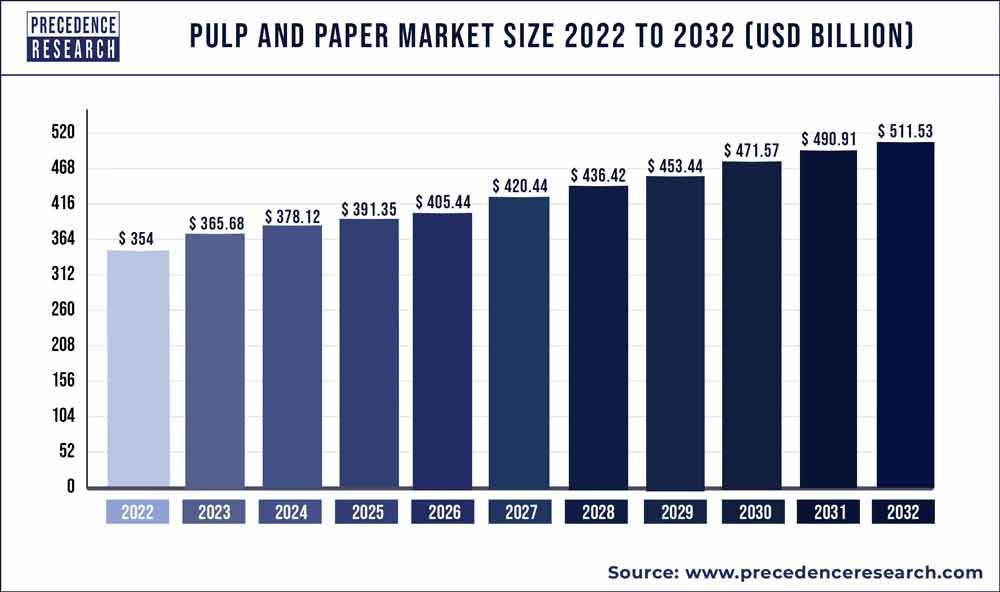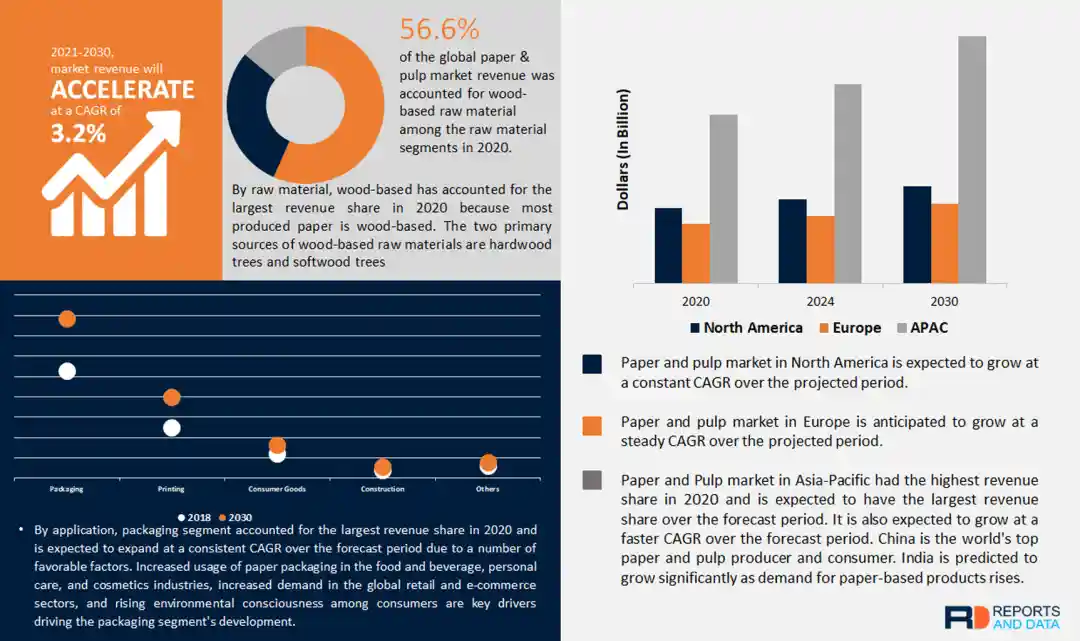How is the Pulp and Paper Industry Adapting to Environmental Regulations?
Pulp and Paper Industry Analysis: Market Overview
The global pulp and paper industry is a dynamic and essential sector that plays an integral role in various industries and daily human life. This market overview will provide valuable insights into the current market size, key players, and the impact of technological advancements and environmental regulations on the industry.
Current Market Size of the Global Pulp and Paper Industry
The global pulp and paper market has experienced steady growth over the years. In 2021, the market size was valued at USD 351.53 billion, and it is projected to reach USD 372.70 billion by 2029, with a compound annual growth rate (CAGR) of 0.72%. The Asia Pacific region dominates the market, accounting for 49.78% of the market share in 2021, with China being a key producer and consumer.
Key Players in the Pulp and Paper Market
Several key players contribute to the growth and development of the pulp and paper industry. These include International Paper, Georgia-Pacific, Nine Dragon Paper, and Stora Enso, among others. International Paper, with a market share of 6.35%, is a global leader in producing corrugated packaging, pulp, and paper products.
Impact of Technological Advancements and Environmental Regulations
Technological advancements and environmental regulations have significantly shaped the pulp and paper industry. Advancements in technology have improved operational efficiency, production capacity, and product quality. However, the industry has also been impacted by the need to comply with evolving environmental regulations.
- Technological Advancements: The pulp and paper industry has witnessed advancements in various areas, such as automation, digitalization, and process optimization. These technologies have improved operational efficiency, reduced waste, and increased product quality. For example, the adoption of digital platforms and artificial intelligence (AI) has helped streamline supply chain management and enhance production planning.
- Environmental Regulations: The pulp and paper industry has faced increasing pressure to adopt sustainable practices and reduce its environmental impact. Deforestation, water consumption, and carbon emissions are major concerns for the industry. To address these issues, companies are focusing on responsible sourcing of raw materials, clean production processes, and transparency in their operations. Organizations like the World Wildlife Fund (WWF) promote sustainable fiber sourcing and monitor companies for deforestation and unsustainable practices.
Conclusion
The pulp and paper industry is a vital sector that serves various industries and daily human needs. It continues to evolve and adapt to technological advancements and environmental regulations. The current market size of the industry is significant, with key players driving its growth and innovation. In order to ensure long-term sustainability, the industry is embracing responsible sourcing, adopting eco-friendly packaging materials, and actively working towards reducing its environmental impact. As the demand for paper and paper-based products continues to grow, the pulp and paper industry will continue to play a crucial role in our global economy.
Environmental Impact and Sustainability Practices
The pulp and paper industry has a significant environmental footprint, impacting forests, water resources, and air quality. However, companies are increasingly adopting sustainable practices to minimize these impacts and ensure responsible sourcing and production.
Environmental Impacts Associated with the Pulp and Paper Industry
The pulp and paper industry relies heavily on wood, with 33-40% of all industrial wood traded globally used in its operations. This high demand has led to deforestation, conversion of high conservation forests, and illegal harvesting. Between 2004 and 2017, over 160,000 square miles of forest were lost in deforestation hot spots.
These unsustainable practices have detrimental effects on ecosystems and species, causing soil erosion, climate impacts, and the loss of biodiversity. Additionally, the industry consumes substantial amounts of water and releases effluents that can pollute water bodies if not managed properly.
Sustainable Practices in Pulp Production and Packaging
Companies in the pulp and paper industry have recognized the need for sustainable practices and are adopting various measures to minimize their environmental impact. One area of focus is sustainable pulp production. This involves sourcing wood from responsibly managed forests, promoting reforestation, and using alternative fibers like recycled materials.
Pulp producers are also implementing technologies to minimize water consumption and effluent discharge. For example, closed-loop systems and water recycling processes are employed to reduce the industry's water footprint. Furthermore, energy-efficient equipment and processes are being implemented to reduce greenhouse gas emissions.
In terms of packaging, there is a growing demand for eco-friendly materials. Companies are exploring alternatives to traditional, non-recyclable packaging materials, such as plastics. Eco-friendly packaging options include paper-based materials derived from sustainably sourced fibers. This shift towards responsible packaging aims to reduce waste and promote a circular economy.
Initiatives to Promote Responsible Sourcing and Reduce Deforestation
To address the challenges of deforestation and irresponsible sourcing in the pulp and paper industry, various initiatives and organizations are working towards promoting responsible practices. One such organization is the World Wildlife Fund (WWF), which focuses on sustainable fiber sourcing and recycling through its Forests Forward program.
The WWF monitors companies for deforestation, human rights violations, and unsustainable practices. By engaging with industry stakeholders and implementing stringent standards, the WWF aims to ensure that the pulp and paper industry operates in a responsible and sustainable manner. These efforts not only benefit forests and ecosystems but also contribute to the livelihoods of local communities and the overall economy.
In conclusion, the pulp and paper industry has significant environmental impacts, but companies are increasingly adopting sustainable practices to minimize these effects. By focusing on sustainable pulp production, eco-friendly packaging materials, and responsible sourcing, the industry is moving towards a more environmentally responsible future. Initiatives like the WWF's Forests Forward program play a crucial role in promoting transparency, clean production, and responsible sourcing. With continued efforts and collaboration, the pulp and paper industry can achieve a balance between economic growth and environmental conservation.
Industry Segmentation and Growth Trends
Market Pulp
Market pulp is one of the major grades in the pulp and paper industry. It is predominantly used for the production of various paper and board products. In recent years, the market pulp segment has witnessed steady growth.
One of the key growth trends in the market pulp segment is the increased demand for sustainable packaging materials. With consumers becoming more conscious of the environmental impact of their purchasing decisions, there has been a shift towards eco-friendly packaging solutions. Market pulp, being a renewable and biodegradable material, is well-positioned to meet this growing demand.
However, the market pulp segment also faces its fair share of challenges. One of the main challenges is price volatility. Market pulp prices are influenced by various factors such as supply and demand dynamics, currency fluctuations, and production costs. Fluctuating prices can affect the profitability of pulp producers and create uncertainty in the market.
Additionally, changing regulations and environmental standards can also pose challenges for the market pulp segment. As governments and regulatory bodies impose stricter regulations on emissions, water usage, and sustainable sourcing, pulp producers need to adapt their operations to comply with these requirements.
Tissue and Towel Sector
The tissue and towel sector is another significant segment in the pulp and paper industry. Tissue products such as toilet paper, tissues, and paper towels are widely used in households, commercial establishments, and the healthcare sector.
In terms of growth and capacity, the tissue and towel sector has been performing well. The sector has experienced a compound annual growth rate (CAGR) of 4.25% since 2020. This growth can be attributed to several factors.
Firstly, the increasing population, urbanization, and changing lifestyles have led to higher demand for tissue and towel products. Moreover, the COVID-19 pandemic has further boosted the demand for tissue paper, particularly in the healthcare sector.
Several regions have witnessed significant capacity growth in the tissue and towel sector. China, Turkey, and Mexico, for example, have seen substantial investments in tissue production facilities. This increased capacity is aimed at meeting the growing demand for tissue products in both domestic and international markets.
Major companies operating in the tissue and towel sector have reported significant increases in sales and volumes. For instance, Cascades and Kimberly-Clark, two prominent players in the industry, have seen a surge in tissue sales, driven by increased consumer demand.
However, despite the positive growth trends, the tissue and towel sector also faces challenges. The sector is highly competitive, with numerous players vying for market share. Moreover, fluctuating raw material prices, energy costs, and transportation expenses can impact the profitability of tissue producers.
Printing and Writing Paper
The production of printing and writing paper is influenced by various factors, including regional demographics, economic conditions, technological advancements, and environmental regulations.
In recent years, the printing and writing paper segment has faced some challenges. The increasing digitization of content and the rise of electronic media have resulted in a decline in demand for printed materials. As a result, the segment has experienced a negative CAGR of -1.68% since 2020.
However, it is worth noting that the printing and writing paper segment has shown growth in certain regions, particularly in Asia. Countries like China and India have witnessed an increase in demand for printing and writing paper. The Indian Paper Manufacturers Association, for example, reported a 214% surge in imports of uncoated printing and writing paper in the first quarter of the year.
The printing and writing paper segment is also influenced by environmental regulations and sustainability practices. As companies strive to reduce their environmental footprint, there is a growing demand for recycled and eco-friendly paper products. Market players are investing in research and development to develop sustainable alternatives and improve the environmental performance of printing and writing paper.
In conclusion, the market pulp segment, the tissue and towel sector, and the production of printing and writing paper in different regions exhibit diverse growth trends and face unique challenges. Sustainable packaging initiatives, changing consumer preferences, and environmental regulations are some of the key factors influencing the growth and performance of these segments.
FAQs about Pulp and Paper Industry Analysis
What is the formula for precision in the context of the pulp and paper industry analysis?
In the context of pulp and paper industry analysis, precision is calculated as follows: Precision = true positives (tp) / (tp + false positives (fp)).
How can I calculate recall when analyzing the pulp and paper industry?
When analyzing the pulp and paper industry, recall is determined using the formula: Recall = true positives (tp) / (tp + false negatives (fn)).
What role do technological advancements play in the pulp and paper industry?
Technological advancements in the pulp and paper industry enhance operational efficiency and product quality, ultimately improving the industry's performance.
How are environmental regulations impacting the pulp and paper industry?
Environmental regulations influence the industry by driving initiatives for sustainable practices, responsible sourcing, and compliance with evolving environmental standards.
What are some of the challenges faced by the market pulp segment?
The market pulp segment faces challenges such as price volatility, regulatory changes, and the need to adapt operations to comply with environmental standards.
In conclusion, we've explored the global pulp and paper industry dynamics.
Key players drive growth amid challenges.
Technology and regulations shape the industry.
Market pulp, tissue, and writing paper trends vary.
Environmental impacts spur sustainable practices and responsible sourcing.
Stay informed on industry trends for informed decision-making.





